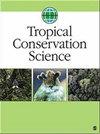厄瓜多尔安第斯秃鹰的生活史
IF 1.6
4区 环境科学与生态学
Q2 BIODIVERSITY CONSERVATION
引用次数: 0
摘要
背景与研究目的:关于安第斯秃鹰(Vultur gryphus)繁殖行为的信息很少。据估计,安第斯秃鹰的全球成年种群数量为 6700 只,在其分布范围内数量不断减少。厄瓜多尔的濒危秃鹰种群数量不到 150 只,其保护状况令人担忧。本研究旨在分析厄瓜多尔野生安第斯秃鹰的繁殖行为。研究方法在 2009 年至 2021 年期间,我们监测了 8 个安第斯秃鹰巢的 22 次产卵尝试,评估了 3 对繁殖秃鹰的父母照料情况,记录了该物种在雏鸟哺育季节与其他猛禽和哺乳动物的互动,并考察了一对安第斯秃鹰在十年监测期间的繁殖成功率。结果:我们的繁殖记录表明,安第斯秃鹰全年产卵,16只雏鸟在巢中度过了6至10个月后才首次飞行。我们发现父母与雏鸟在一起的时间长短不一,并描述了在秃鹰筑巢区,秃鹰与其他猛禽和一只阔叶熊(Tremarctos ornatus)之间的争斗。受监测的一对兀鹰的繁殖成功率为每窝 0.88 只雏鸟,雌鸟平均每 15 个月产下一枚蛋。结论考虑到厄瓜多尔的安第斯秃鹰种群规模较小,对野生秃鹰繁殖行为的研究是评估种群趋势和防止灭绝的首要研究任务。具体而言,我们建议进一步研究父母照顾、繁殖成功率、雏鸟存活率和筑巢物候学。对保护的影响:除了保护区系统的重要性之外,为维护安第斯山脉北部兀鹰种群而对关键区域进行的战略规划必须包括对新的潜在保护区进行评估,以便为这些鸟类提供直接利益。这些保护区应包括安第斯农村地区等人类主导景观中的筑巢地点。本文章由计算机程序翻译,如有差异,请以英文原文为准。
Life History of the Andean Condor in Ecuador
Background and Research Aims: Little information exists on the breeding behavior of the Andean Condor ( Vultur gryphus). Its global population, estimated at 6700 adult individuals, is declining throughout its distribution range. With less than 150 condors, the Endangered condor population in Ecuador is of conservation concern. This study aimed to analyze the breeding behavior of wild-born Andean Condors in Ecuador. Methods: Between 2009 and 2021, we monitored 22 egg-laying attempts in eight Andean Condor nests, evaluated the parental care of three breeding pairs of condors and recorded the species' interactions with other raptors and mammals during the nestling-rearing season, and examined the breeding success of an Andean Condor pair during a decade of monitoring. Results: Our breeding records indicated that Andean Condor lay eggs throughout the year, and 16 nestlings spent between six and 10 months in the nest before making their first flights. We found differences in the length of time that the parents remain with the nestling, and described agonistic encounters between condors and other raptors and a Spectacled Bear ( Tremarctos ornatus) in the condor nesting areas. The breeding success of the monitored condor pair was 0.88 nestlings per clutch, and the female laid an egg on average every 15 months. Conclusion: Considering the small size of the Andean Condor population in Ecuador, studies on the breeding behavior of wild-born condors are a high research priority to assess population trends and prevent extinction. Specifically, we recommend further research on parental care, breeding success, nestling survivorship, and nesting phenology. Implications for Conservation: Beyond the importance of the protected area system, strategic planning of key areas for the maintenance of condor populations in the northern Andes must encompass the evaluation of new potential protected areas that offer direct benefits to these birds. These should include nesting sites in human-dominated landscapes such as rural Andean areas.
求助全文
通过发布文献求助,成功后即可免费获取论文全文。
去求助
来源期刊

Tropical Conservation Science
BIODIVERSITY CONSERVATION-
CiteScore
3.60
自引率
5.90%
发文量
16
审稿时长
>12 weeks
期刊介绍:
Tropical Conservation Science is a peer-reviewed, open access journal that publishes original research papers and state-of-the-art reviews of broad interest to the field of conservation of tropical forests and of other tropical ecosystems.
 求助内容:
求助内容: 应助结果提醒方式:
应助结果提醒方式:


